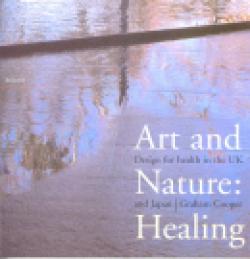Art and Nature: Healing - Design for health in the UK and Japan

By Graham Cooper, Edited by Dennis Sharp
BookART in collaboration with the Great Britain Sasakawa Foundation (2006)
ISBN-13: 978-0947648039
Review by Sandra Lawman
Ted Hughes said: "Art is in general the psychological component of the immune system. As the body tries to heal itself from any stress or shock or infection, the corresponding harmonic in consciousness is art."
This book not only propounds this philosophy, it also recommends action to improve health architecture in both countries, and the underlying tenet is that a patient's surroundings should make him or her better rather than worse. Increased levels of stress and depression are associated with sterile, boring architecture, whereas enhanced levels of recovery come from natural light and water, and an affinity with the environment.
It is difficult to do justice to this carefully crafted selection of essays in a short review. It is a book to delight in, to dip into or read from cover to cover, and which has stunning examples of the art and architecture it refers to. It is solidly grounded on evidence based design, and explores in depth issues and ideas on the future of healing environments.
With the projected new spending on health buildings by the NHS, and with the impetus of the Forum for the Healing Environment in Japan, the author exhorts the reader to take this opportunity to bring together patients, architects and healthcare professionals to influence the design of new facilities and bring a holistic and symbiotic approach.
Whether the cash-strapped managers of health services are listening is another matter, but there is a groundswell of opinion towards promoting wellbeing in its widest sense rather than merely treating sickness, and this is a timely contribution to that debate.
There are examples of good practice in both countries, such as the Community Care Centre in Lambeth, the Glasgow Homeopathic Hospital, Hyogo Rehabilitation Centre in Kobe and the Sea Ward Stress Care Centre in Ohmuta. The general theme is that more of these kinds of facilities are needed. Editor Dennis Sharp skilfully draws together the examples of good practice, and compares and contrasts different facilities.
There are valuable contributions from the highly regarded physician Shigeaki Hinohara, and from Yasushi Nagasawa, Professor of Architecture at The Tokyo University, both of whom are involved in the awards for the Forum for the Healing Environment.
Some of the differences between the Japanese and British approaches are articulated, such as the valuing of space by the Japanese, and therefore more creative use of it, and Japanese sensitivity to seasonal changes, arising largely from Shinto beliefs. The concept of "Shakkei" is referred to, where the distinction between the building and the environment it is in are almost dissolved, particularly at the Sea Ward Stress Centre.
The scale of this book is enormous, and the Nature of Health Design Project is Graham Cooper's big undertaking. In Japan there are 20,500 centenarians and an organisation called "Design for Age." Perhaps the Arts Council of Great Britain should take that into account in its new Arts health and wellbeing strategy.
Art and Nature: Healing, would be a valuable addition to anyone's library, or indeed coffee table. (Books available from: G. Cooper, Harmonie, Peak Hill, Sidmouth, Devon EX10 0NW)
First having taught English in Japan 25 years ago, Sandra Lawman worked for a major Japanese company for several years in London before joining an environmental NGO for five years, as well as being active in local and national politics. She now manages the Charitable Funds of the South London and Maudsley NHS Trust, and has recently undertaken a visit to Japan to study the mental health service user movement there, courtesy of the Great Britain Sasakawa Foundation.

